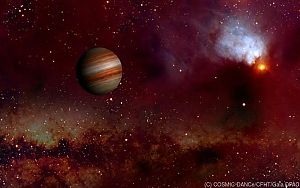170 vagrant planets discovered in near-sun star factory

These orbit no star, they are homeless, so to speak. The large number of these solitary planets provides information about their formation, the researchers report in the scientific journal "Nature Astronomy".
Ten years ago, the discovery by two teams of astronomers caused a sensation when they used gravitational lensing to detect ten planets that were not bound to any star. Based on their discovery, they extrapolated that there could be twice as many masterless planets in the Milky Way as there are stars.
Formation history still mysterious
The origin of these free-floating planets (FFPs) is still a mystery. Either they are formed like stars by the gravitational collapse of small gas clouds, or they form like planets around stars but are then ejected from their star system. However, to determine which mechanism is more likely, a larger homogeneous sample of FFPs has been missing until now.
The research team led by Hervé Bouy from the University of Bordeaux (France), which also included Núria Miret Roig from the Institute of Astrophysics at the University of Vienna, set its sights on a so-called stellar association as part of the European project "Cosmic-Dance". These are open star clusters in which the stars are no longer bound to each other by gravity.
170 vagrant planets
By analysing tens of thousands of images taken over a period of 20 years, they discovered 170 previously unknown vagrant planets in the young "Upper Scorpius Association", which is about 400 light years away. As the University of Vienna announced in a press release, this is the largest sample of FFPs in a single stellar association. In addition, the findings doubled the total number of previously known solitary planets.
"The large number of FFPs discovered suggests that the dynamic ejection of planetary systems is an important mechanism for their formation, as the collapse of gas clouds would not lead to so many FFPs," Miret Roig explained. The result also suggests relatively short formation periods of giant planetary systems in the range of about three to ten million years.
For the scientists, the newly discovered vagrant planets are excellent targets for follow-up studies, especially for the investigation of planetary atmospheres without a dazzling host star. In addition, they could be used to study the presence of gas and dust around FFPs to shed light on their formation process.
If the proportion of loner planets in other star-forming regions is as high as in the "Upper Scorpius Association", there could be several billion loner planets the size of Jupiter travelling in the Milky Way without a host star, the researchers point out. There could even be many more of Earth-sized planets, as they are more common than massive planets.
